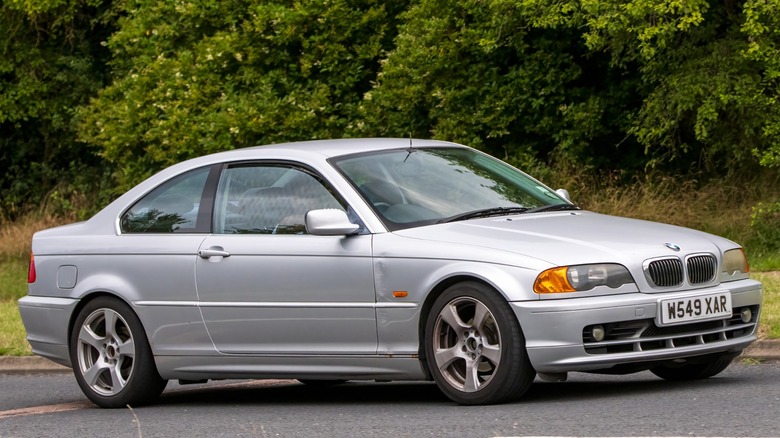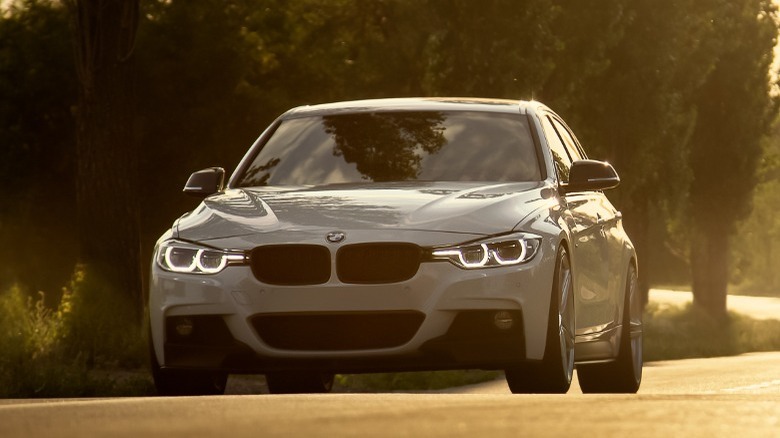A Quick Guide To The BMW 328i Engine: What You Need To Know
Introduced to the market in 1975, the BMW 3 Series is the German automaker's most prolific lineup throughout the years. As the successor to the impactful 02 model, the 3 Series raised the bar for what a sports luxury compact car can deliver right off the bat and has been the benchmark for other competitors ever since.
Throughout seven generations of the 3 Series, BMW offered a wide range of variants with different body styles and powertrains. One of the most iconic models of the 3 Series, the 328i, first entered the market in 1995, a few years after the introduction of the third generation of the lineup.
Since its debut, the 328i stood its ground as an icon of high-end sports luxury with a rear-wheel drive configuration. Later on, BMW introduced AWD as an upgrade for later models. But, arguably, the most significant aspect of the 328i is the powertrain. While delivering impressive horsepower and torque to the tarmac, these engines had their fair share of troubles and headaches here and there.
First iteration: BMW E36 328i (1995-1998)
The first 328i model rolled out of the factory in 1995 as an updated version of the 325i. BMW put its six-cylinder M52 engine under the E36 328i's hood, which was a replacement for the M50 engine with a few tweaks and upgrades. Excluding the models that bore the "M" badge, the E36 328i had the most potent powertrain compared to other 3 Series models from its time. The 2.8L M52B28 engine in the E36 could produce 190 horsepower and 210 lb-ft of torque.
These engines earned a reputation for showing impressive strength and resilience. The simplicity of the M52B28 engine makes it ideal for those looking for a project car that can easily be modified. However, these engines are over 25 years old, and you should be prepared to face some mechanical issues if you opt for one.
Some of the common problems that come with E36 328i models are oil leakage from the gasket and water pump failure, which usually occurs after 100,000 miles. Also, BMW's double-VANOS system in M52 engines is prone to failure, resulting in rough idles and a sudden drop in performance.
Second iteration: BMW E46 328i (1998-2000)
Although it had a short production run, the E46 328i is an extremely popular choice among car enthusiasts. It was offered as a two-door coupe and sedan, but there was no convertible model like the E36 328i. BMW made an enhanced version of the M52 in the E36, labeling it a "Technical Update." The 52TUB28 powertrain in the BMW E46 came with power output numbers similar to the previous model: 190 ponies and 210 lb-ft of torque.
The problems haunting the E46 328i are also similar to the E36 model, especially models with higher mileage. One of the first areas you should pay attention to is valve covers. Many owners noticed cracks in those covers, resulting in oil leakages. Despite the technical updates, the double-VANOS system in the E46 was still causing issues. What's more, problems with the radiator and the water pump can cause the M52 engine to overheat.
Third iteration: BMW E90 328i (2007-2013)
After six years, BMW introduced another 328i variant for the fifth-gen 3 Series. This time, BMW offered the E90 328i in convertible, coupe, sedan, and wagon body styles to appeal to a larger audience. The 3-liter N52 engine was the last naturally aspirated inline-six that BMW used for 328i models. Since the engine block was made of magnesium and aluminum, it weighed significantly less than the cast-iron M52 in the BMW 3 Series E46 328i.
The N52 filled the shoes of its predecessor well. With over 215 horsepower and 199 lb-ft of torque, the N52 became one of the most popular European-made naturally aspirated six-cylinder engines of its time. Some upgrades that BMW introduced with the N52 were a variable valve lift system, an electric water pump, and a variable output oil pump.
The ignition coils were one of the most common faulty parts within these engines. Due to poor maintenance or worn spark plugs, the coil had to work overtime, resulting in an ignition coil failure. Another recurring issue for the N52 was the water pump failure. Issues with the double-VANOS and oil leakage continued plaguing the 3 Series, and models equipped with the N52 were no exceptions. Powertrain-related problems with the fifth-gen 3 Series made many question the reliability of BMW.
Fourth iteration: BMW F30 328i (2011-2015)
The last time BMW used the 328i nameplate was through the sixth generation of the 3 Series, from 2011 to 215. Instead of a six-cylinder, the F30 328i now featured a turbocharged inline-four powertrain, dubbed the N20. Thanks to the twin-scroll turbo mounted on the engine, the N20 offered plenty of torque in lower RPMs. Despite a smaller displacement, the 2.0L N20B20 could produce 241 horsepower and 258 lb-ft.
Similar to the previous models, the powertrain in the BMW F30 328i has a lot of room for aftermarket parts and modifications. You can get significantly more HP out of the N20 engine with bigger air intakes and an ECU remap.
Compared to the previous models, the N20 engine is more reliable, though it still needs a couple more years to see if it can pass the test of time. However, oil leakage from cracked valve covers and valve cover gaskets is still an ongoing issue. Some earlier models had major issues with the timing chain guides breaking prematurely and severely damaging the powertrain.
Which 328i engine should you go for?
The perfect BMW 3 Series 328i can vary depending on your needs, goals, and preferences. If you're looking for a more straightforward and vintage layout to work on, models with the M52 powertrain offer a lot of room for easy-to-install aftermarket upgrades.
On the other hand, N20 engines are more complicated to work on due to forced induction, but the difference in stock power output is easily noticeable. The turbocharger gives the engine a good kick in lower RPMs, making the driving experience around the city a lot more engaging.
Regardless of what model you go for, you should always watch out for problems such as oil leakage and cracked water pumps when you're looking for a 3 Series 328i. Most of the engine-related issues with these BMWs come from years of abuse and poor maintenance. So, it's a safer bet to carefully check the vehicle's history and maintenance reports before you finalize your purchase.





